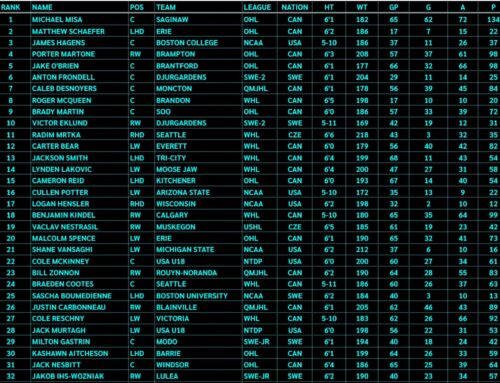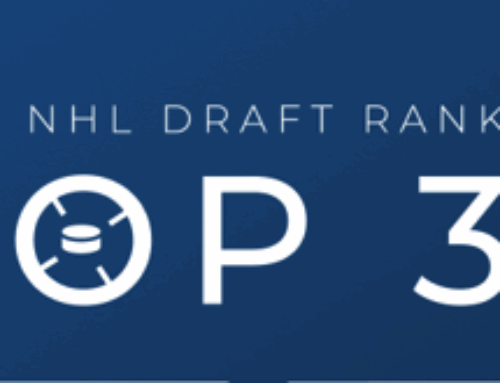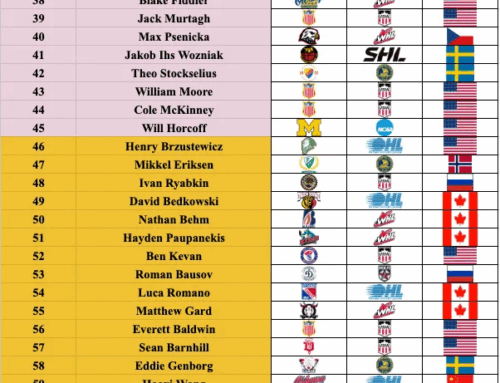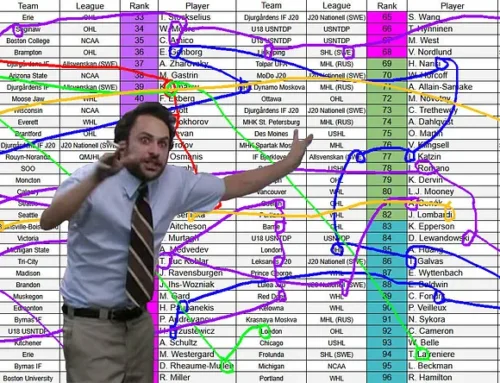Contender Series: Michigan Made
Tony Ferrari
2020-10-30

Graphic Courtesy of Andrew Armstrong
The 2021 NHL Draft is setting up to be one of the most unique in recent memory. There is no clear-cut number one prospect as there is most years with a player such as Alexis Lafrenière or Auston Matthews. The 2021 class has doesn’t even have a two-horse race in the making. Rather, the 2021 group has a large group of talent that could be vying for the top pick. The ‘Contender Series’ will profile some of the contenders for the first overall pick in the 2021 NHL Draft. Each edition will feature three prospects who all, to varying degrees, have a shot at first overall. This will serve as a four-part kick-off to the monthly draft reports that will be out the final week of each month until the draft. The four-part series will focus on a different grouping of prospects:
Fascinating Forwards Big-3 Blueliners
Michigan Made Wild Cards
The 2021 NHL Draft class is full of storylines with one of the biggest being the prospects coming out of U.S. programs. The U.S. National Team Development Program is stocked full of talent and although they may not reach the heights of the 2001-born group with Jack Hughes, Cole Caufield, et al, they have their own Jack Hughes (seriously, no relation, same name) and a cupboard full of talent that includes the youngest Hughes brother, Luke. They also feature a glut of high-skill forwards who bring a ton of high-end talent to the team that they may have been lacking in last year’s 2002-born group. There is also the loaded University of Michigan roster with both Owen Power and Kent Johnson eligible for the 2021 NHL Draft and expected to be top picks. Needless to say, if there wasn’t a global pandemic the place to be in North America in terms of scouting and analyzing draft prospects might be the state of Michigan.
RW/C Chaz Lucius – U.S. National Team Development Program U18 (USHL)
6’0″ – 172lbs – May 2, 2003 – American
Arguably the most skilled forward in the draft, Chaz Lucius is an electrifying offensive player who has a great shot and some crafty playmaking. The 6’0” forward has the ability to play center but profiles best as a winger who can slash and gnash opposing teams. The young American was tied for the team lead with the NTDP U17s last year with 50 points in 46 games and played in six games with the U18 squad towards the end of the season, showing that he was more than capable of fitting in with the age group ahead of him. There were even times with the U18s when Lucius seemed to be the best player in their bottom-six.
Chaz Lucius is sick.
This goal was from back in November and I felt like you should see it. #2021NHLDraft #USNTDP pic.twitter.com/lQVb7v2dsk
— Tony Ferrari (@theTonyFerrari) April 5, 2020
Lucius has a high-end offensive skillset that thrives on attacking with energy. His skating is fairly average and although there are some concerns, his mobility overall is high-tempo. He moves his feet and knows where to be in the offensive zone. Skating has become increasingly fixable over the last ten years or so, and with Lucius’ issues not being effort related he should be able to clean up his technique a bit without much issue. Lucius is best as a secondary option in transition, with the ability to stickhandle and maneuver through the neutral zone and enough speed to back defenses off when he attacks the offensive blueline. His first couple of steps in accelerating to his top speed will need work which prevents him from being a high-level difference-maker moving up ice.
Certainly more of a shooter than a playmaker, there is a level of craftiness and pace to Lucius’ playmaking. He is an accurate passer, 85.8% last season according to InStat, but the frequency of his passing is nothing more than average. While he has looked off his fair share of open passes, the NTDP star thrives on creating off the rush. He is a diverse passer when attacking with speed in transition. From making crisp pinpoint passes to the backside of the crease for a tap-in to rotating to find the high man in the slot. He loves to attack a defender head-on, crossing their face and then laying a drop pass into space or making delicate backhand passes against the grain. The biggest problem with Lucius as a playmaker is that he is a bit of a greedy shooter with a great shot that you want him to use.
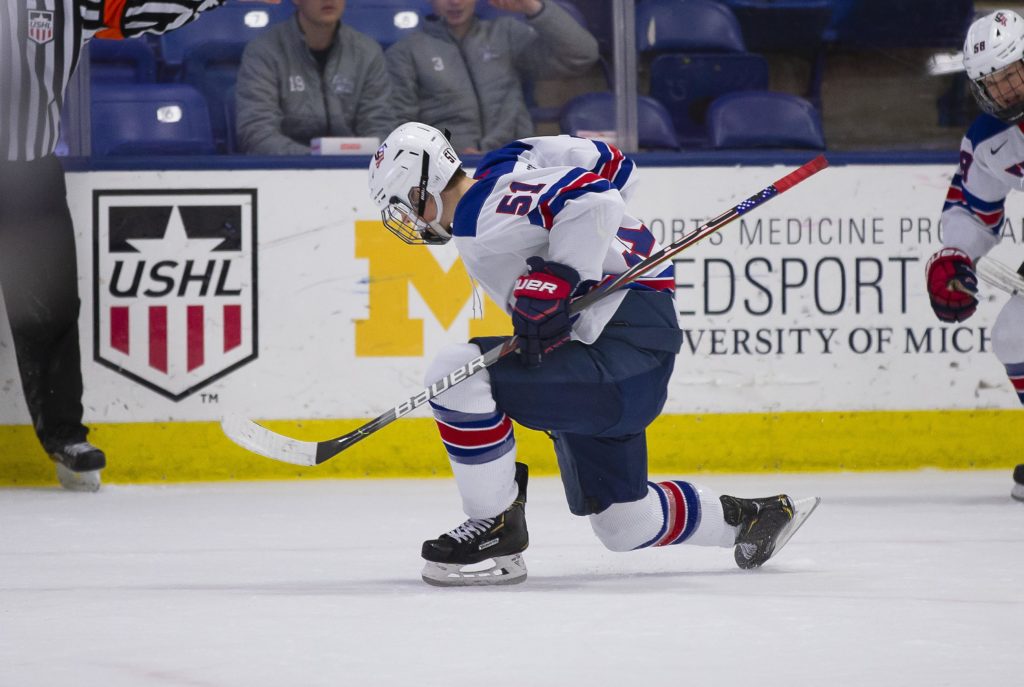
Photo courtesy of the U.S. NTDP
Speaking of his great shot, he can score in a variety of ways. Whether it be a sharp angle snipe over a goaltender’s shoulder or a lightning-quick deke from in tight before tucking it behind a netminder’s outstretched leg, Lucius brings a lot of the ‘wow’ factor that is a bit lacking in the 2021 NHL Draft class. Lucius is a very good stand-and-shoot scorer who can be a lethal weapon on the half-wall on the powerplay. He has the ability to shoot the puck from a variety of stick and hand positions, able to fire shots extended out or from in tight to his body. He likes to roll his wrists to slightly alter angles on the netminder. His hand speed and ability to release his shot seemingly instantaneously make him a hard player to read for defenseman and goaltenders.
There are areas that will need to become more consistent such as his defensive engagement. He has shown the ability to anticipate passes, specifically to the blueline where he has chipped the puck past the defenseman to create an odd-man rush. He shows decent pursuit high in the zone as well. He doesn’t always take away the passing lanes with his stick and sometimes can get a bit behind the play as well. These are all fixable issues and relatively minor for a winger in general.
Lucius brings a ton of skill and precision to the game and his offensive IQ and ability to attack at all times in the offensive zone. He wants the puck on his stick and he doesn’t hesitate to shoot. He may look off passes at times but when he makes a pass, he puts it on the tape of his teammate. He is a difference-maker at the offensive end of the ice and consistently drives good results. Number one may be a long shot but having the conversation without Lucius isn’t a complete conversation.
LHD Luke Hughes – U.S. National Team Development Program U18 (USHL)
6’2″ – 176lbs – September 9, 2003 – American
The 2021 NHL Draft will yet again feature a Hughes brother near the top of the class after Quinn was the 7th overall pick in 2018 and Jack was selected in the top spot by New Jersey in 2019. Luke Hughes brings a lot of the same skill, skating, and upside that his brothers showed in their draft year but he also comes with a 6’2” frame that can fill out and give him the size that was a concern for both of the elder Hughes’ in their draft year. This adds a level of intrigue to the NTDP star’s profile. His September birthday makes him one of the youngest players eligible for this draft class giving him a bit more developmental runway than some of the older prospects in the class such as Owen Power or Aatu Räty who are both late-2002 born prospects.
The strength of Hughes’ game is his skating and fluidity to his mobility. He has a very good stride technically and generates speed quickly. His feet are constantly in motion and he utilizes his edges at a high level, giving him 360-degree mobility in all three zones. Hughes identifies changes in possession and has the ability to transition from attack to defense quite quickly. His footwork is among the best on a highly regarded USA U18 squad that thrives on mobility and speed. When Hughes is at the top of his game, his mobility is at the center of it. His blend of mobility, speed, and skill have all helped him become an excellent transition player over the last couple of seasons.

Photo courtesy of the U.S. NTDP
Offensively, Hughes is a dynamic skater who is at his best when reading the zone and attacking with his passing. He has played quite a bit on a pairing with Sean Behrens, a fellow offensive play driver from the backend, and the two American blueliners both like to attack the play. While they were burned at times in their U17 season last year, they have shown the ability to read and play off each other much better this year and that has allowed them both to be much more effective offensive players. Having the ability to read and play off another mobile offensive-minded defender will aid him in the modern game as more and more players rely on skating and skill on the back end.
Hughes loves to drive to the backside of the net and give the puck carrier a dangerous passing option. He pulsates up and down the wall intuitively to retain possession of the puck and generate offensive chances. His mobility and skating allow him to attack but his IQ and instincts are what make his pinpoint passing dangerous. With the puck on his stick, Hughes has a special ability to find open teammates at a high rate of efficiency with a passing percentage of over 88% on the year thus far. He funnels the puck to dangerous areas and does it with both quality and quantity, consistently driving offense.
It's a 3-0 lead on a gorgeous goal from the U18s. Luke Hughes with the pretty drop to Jeremy Wilmer, who finds Jack Devine for the tally. Tic-tac-toe. #NTDP #PioneerTogether #GoBU #GoBlue pic.twitter.com/vlELZ8685g
— Stars n’ Stripes Hockey (@StarsStripesHKY) October 16, 2020
The other end of the ice is a bit of a mixed bag but there has been some improvement year over year. He has grown and matured a bit physically which has helped him in board battles and net-front boxouts. His willingness to engage in those two areas is still hit-or-miss but the ability is much more evident than it was in March when his U17 season came to an end. He plays defensive transitions very aggressively. He steps up onto an attacker quickly, forcing them to make a move. When a high-skill opponent comes up against him, he can get beat outside and has a tendency to reach with his stick. While he’s gotten away with it and knocked the puck loose much more consistently this season, this will be an area of improvement going forward with him needing to reign in the aggressively tight gap in some situations.
There’s still a long way to go before we put Luke in the same elite category that his blueline brother Quinn has ascended to at the NHL level but the youngest Hughes’ brother outproduced the oldest sibling in their U.S. NTDP U17 years. Luke Hughes has the size that his brothers don’t possess. He also doesn’t have the same high-end skill. That doesn’t mean that he won’t be just as impactful, he will just do it differently. His U17 season The NHL loves to talk bloodlines, they couldn’t stop mentioning it during the 2020 NHL Draft coverage, and Luke may benefit from having some family already with their foot in the door.
LW Kent Johnson – University of Michigan (NCAA)
6’1″ – 165lbs – October 18, 2002 – Canadian
Last season, Kent Johnson made a name for himself by absolutely tearing the BCHL to shreds. This year, he will look to take a step up in competition and help propel the Michigan Wolverines’ offense along with a loaded freshman class that includes Thomas Bordeleau (SJS), Brendan Brisson (ANA), and Owen Power (2021). The crazy thing is, there are many who feel that the kid from Junior A hockey is going to be the best of the bunch. Johnson racked up 101 points in 52 games to lead the BCHL in scoring. That was 30 points more than the next highest scorer in the league, a 19-year-old. To say he was the best player in the league would be an understatement.

Photo courtesy of The Michigan Daily
Johnson’s offensive game is predicated on his IQ and ability to manipulate the offense to take advantage of his soft touch and skill. The future Wolverine is always aware of who is on the ice and where they are. He has eyes in the back of his head at times, making no-look passes with regularity. He makes a habit of carrying the puck behind the net and then passing back to the net front against momentum to throw off defenders and netminders. Like a high-end NFL quarterback looks off the safety to open up a passing route, Johnson has the ability to look off defenders and make a pass to an open teammate. One of the intricacies of his game is how he is able to handle the puck and use the face of his stick blade to imply one thing just to do another. When the puck is on his stick and a defender is closing in, Johnson will open his blade face to the outside. This causes the defender to lean to the outside which is when Johnson has the ability to quickly roll his wrists and pull the puck in and make a pass in the opposite direction. His lightning-quick hands and subtleties to stickhandling manufacture time and space for him to take advantage of.
While Johnson does profile as a playmaker more than a goalscorer at the next level, his ability to find the back of the net is nothing to speak ill about. Johnson has a very good shot. He elevates the puck from in tight and has pinpoint accuracy to score from terrible angles by picking apart the goaltender, finding the smallest of spaces to exploit. His hand-eye coordination is unreal, able to collect errant passes from a foot in the air or snag a pass that winds up behind him. Johnson’s “catch radius” on passes is abnormally large with the ability to corral passes in a variety of body positions. This unique ability and impressive body control also translate to his shot as well. He can fire pucks from in tight or fully extended, shoot off either foot or reaching back while seemingly not have to pull it forward to get the puck off his stick. While his shot isn’t as lethal or heavy as some of the best shooters in this draft, the combination of the accuracy of his shot and the ability to fire it at legitimately any time make him dangerous at all times.
I've been watching a ton of Kent Johnson (#2021NHLDraft) lately and this kid has some skill.
He had TWO Michigan/Svechnikov goals last year. Look how quickly he collects the pass and makes the decision to go for it here.
Imagine he pulls off the Michigan at Yost next season? pic.twitter.com/rF8aVNF7dO
— Tony Ferrari (@theTonyFerrari) October 29, 2020
There have been some who have criticized Johnson’s lack of elite top speed and high-level skating. There are technical issues with his stride as it can get a bit wide at times and he doesn’t always generate the power that one would hope. The issue with this critique is that it doesn’t affect the way he plays or generates chances. Johnson has excellent mobility overall in terms of understanding where to be, when to be there and his timing is impeccable. His offensive zone movement is sneaky and stealthy. He seems to ghost defenders and reappears in open space. Away from the puck, he is incredibly elusive and doesn’t draw attention to himself. At times he can even look disinterested but he does so with a purpose. As soon as he identifies space, he pounces. With the puck on his stick, his deception and manipulation with his puck handling and skill allow for him to create havoc as he changes direction and shifts his center of gravity. Drawing defenders by teasing an outside move, he will make an inside move. Fainting a drive to the inside, Johnson can shift his weight and generate a burst of speed to the outside. This variance on how he can attack makes him one of the highest upside forwards in the entire 2021 NHL Draft!
He has shown an ability to be a good defensive player who plays a responsible and engaged defensive game. He anticipates play very well and seems to understand what his opponents want to do. Much like the rest of his game, there is some trepidation on how well that he will translate to the next level strictly due to the fact that the highest level he played was Canadian Junior A in the BCHL. It’s much easier to play capable defense at that level so seeing how he plays at Michigan this upcoming season. The key to where Johnson gets drafted will be based on how he plays with the Wolverines. If he struggles a bit and doesn’t take on a major offensive role with U of M, he could wind up being drafted in the 10-20 range, similar to Dylan Holloway this past draft. If he takes on that role at Michigan and plays the style of game he’s capable of and finds success, he could challenge for number one. The variance in his draft range is there for Kent Johnson but the upside, skill, and elite IQ all lead you to believe that he should be in that conversation all year long.
*******
Michigan is going to be a hotbed for hockey in 2020-21 with the U.S. NTDP U18 squad being stacked and the University of Michigan welcoming in a freshman class that comes with all of the hype – and hopefully none of the flop – that last years Wisconsin freshman group came into the year with. This isn’t even taking into account the U.S. NTDP U17 squad or the Flint Firebirds and Saginaw Spirit, all three expected to be entertaining and talented teams. The COVID-19 pandemic may limit in-person viewings but tracking Chaz Lucius, Luke Hughes and a squad that features other high-end talents such as Sean Behrens and Aiden Hreschuk on the backend with Jeremy Wilmer, Sasha Pastujov and so many others upfront will be a blast. Michigan will be full of talent as well with Kent Johnson and Owen Power, who we will cover on Monday, among others battling it out in the Big-10 conference when the NCAA season gets started. If you aren’t paying attention to the state of Michigan, you’ll miss a lot of great hockey!
Take a look at the DobberProspects Scouting team’s November Top-100 for the 2021 NHL Draft here!
Be sure to come back and check out the rest of the ‘Contender Series’ with the ‘Michigan Made’ trio coming up on Friday and the final two parts coming out on Monday and Tuesday! For more prospect talk or to reach out to me, follow me on Twitter at @theTonyFerrari! You can hear me and Jokke Nevalainen, the Head of European Scout for DobberProspects, on our NHL Draft centric podcast, Dobber’s DraftCast! We just had Scott Wheeler from The Athletic on to kick off the 2021 NHL Draft coverage! We are on a short post-draft break right now but will be back in early-mid November with top of the line NHL Draft coverage!
For your fantasy hockey needs, the DobberProspects Fantasy Prospect Report and Fantasy Guide are the best sources to get you ahead of the game in your league whether you play in a simple year-to-year league or you’re involved in a decade long keeper league, the DobberProspects’ Fantasy Guides are your one-stop-shop for winning your league!



